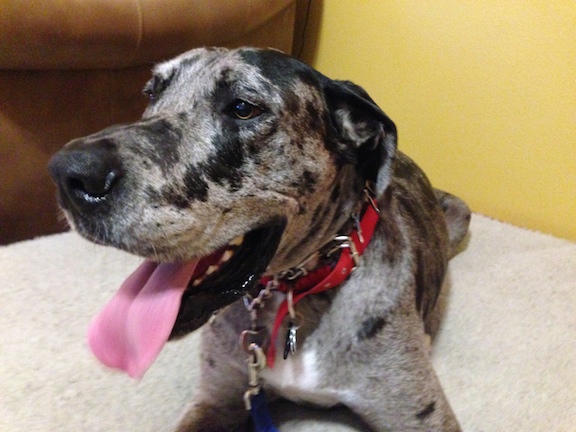Teaching Sam, He is Not THE MAN!
By: David Codr
Published Date: June 30, 2014
 Sam is a three-year-old Great Dane. His owners called me to put an end to his intense case of dog aggression. Sam’s current owners rescued him when he was a little over two years old, but they didn’t know about the dog aggression until he got to their home and took a bite out of the family’s seven-year-old Shih Tzu.
Sam is a three-year-old Great Dane. His owners called me to put an end to his intense case of dog aggression. Sam’s current owners rescued him when he was a little over two years old, but they didn’t know about the dog aggression until he got to their home and took a bite out of the family’s seven-year-old Shih Tzu.
I have to say the above photo of Sam doesn’t do him justice. Ive worked with a number of large breed dogs, but Sam is in my top five for sure. If i remember correctly his owner said he was in the 160 lb range and he looked every bit of it.
When I met him in person, I was concerned that Sam showed little to no respect for his owner’s personal space. While he responded to some of their commands and wasn’t showing any dominance or aggression, I could sense that he did not fully respect their authority.
Whenever you have a dog that has an aggression issue, you have to install a solid foundation of respect for the authority of the dog’s owners. Many of my clients mistakenly think I will do a dog aggression session at a dog park. But when a dog has a serious case of aggression, the last thing you want to do is expose it to more dogs unless you have control of the dog.
There is no way you can control a giant breed dog unless it has a healthy respect for its owner’s authority. I believe the best way to deal with dog aggression, is to build up the dog’s respect for its owner by installing rules and structure to its daily life.
I suggested a few new easy to adopt and enforce rules, went over new ways for Sam’s owners to communicate with him through body language and new ways of disagreeing with unwanted behaviors. Because Sam has been engaging in these behaviors for a while, it will take a week or two of timely and consistent corrections before he starts to form new habits.
Sam’s owners had gotten into the habit of physically interacting with him when he sat on top of their feet or invaded their personal space. But pushing or shoving a dog doesn’t communicate that the initial behavior was unwanted.
Instead I showed them how they could stand up and define their personal space whenever Sam got too close. At first his owner’s movements were slow and lacked definition so Sam didn’t pay much attention. But as the session went on, he responded to their corrections better and faster, even sitting down a foot or two away instead of plopping down right on top of there feet as he did before.
To help redefine the leader follower relationship, I demonstrated a leadership exercise that required Sam to restrain himself. At first he was uninterested as the treat I was using didn’t appeal to him. His owners suggested we tried and cheese and that did the trick. I was able to get Sam to leave the cheese on the floor until I gave him permission to have it.
After demonstrating it a few times, I brought his primary owner up to repeat the exercise. Because she was slow and indecisive in her movements. Sam ignored her and pushed his way to get to the cheese on the floor. But after a few small corrections, Sam’s owner was completely successful on the second try.
I had the other members of the family run through the exercise as well so they can practice it daily for the next few weeks. By practicing this exercise consistently and increasing the level of difficulty, Sam will learn to restrain himself and look to his owners for guidance when in doubt.
This ability to self restrain is crucial in the rehabilitation process when you are dealing with dog aggression. A dog needs to have practice at stopping when corrected and a full respect for his owner’s authority before you can start to slowly expose the dog to other dogs in controlled situations.
It will take some time and practice before Sam starts to see and identify himself as being in the follower position. Based on how responsive Sam was to the new communication methods and leadership exercises, Im confident he will quickly become a balanced dog who respects his owners as authority figures. Once that’s the case, they can start to slowly desensitize their dog to the sight and presence of other dogs.
Categorized in: Dog Behavior, Dog Psychology, Dog trainer in omaha, Dog trainer Nebraska, Dog Training Omaha, Nebraska dog training



